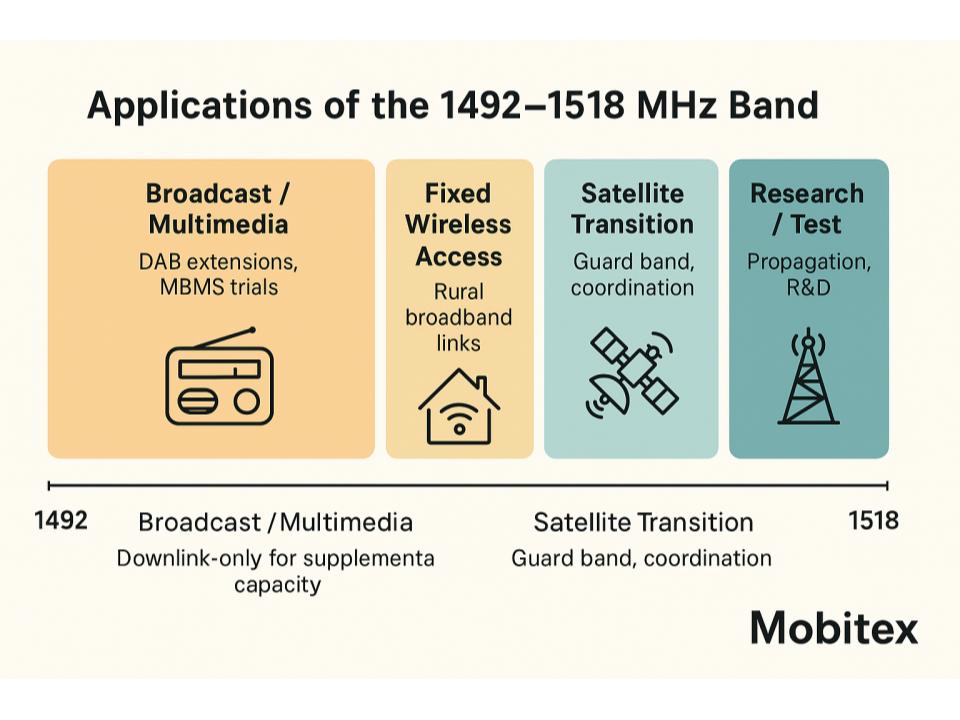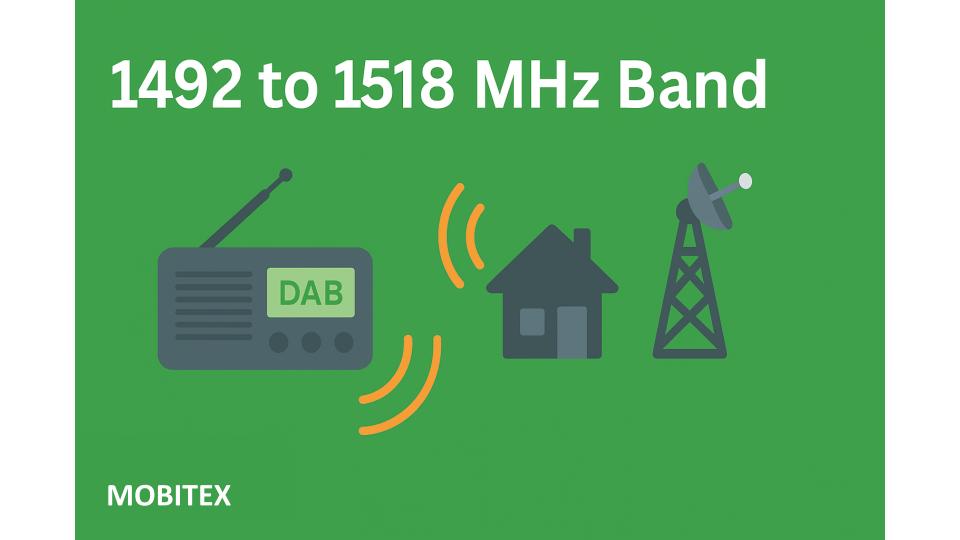🌍 Overview
The 1492–1518 MHz band marks a pivotal transition zone in the L-Band spectrum. It sits directly above the Digital Audio Broadcasting (DAB/DAB+) multiplexes (1452–1492 MHz) and below the Mobile-Satellite Service (MSS) downlinks that begin around 1525 MHz. This range has become a hotbed for supplemental downlink (SDL) allocations and fixed wireless broadband systems in certain markets.
In essence, it’s a shared frontier between terrestrial and satellite communication ecosystems, demanding careful coordination and tight emission control.
📶 Frequency Range and Band Geometry
- Lower Edge: 1492 MHz
- Upper Edge: 1518 MHz
- Span: 26 MHz
- ITU Regions: Primarily Region 1 (Europe/Africa), with variable usage in Regions 2 and 3
- Neighbor Bands:
- Below: 1452–1492 MHz (DAB/DAB+ & LTE Band 32 SDL)
- Above: 1518–1525 MHz (guard segment leading to MSS downlink 1525–1559 MHz)
This band forms the upper part of the L-Band SDL spectrum, bridging terrestrial and satellite allocations. It often overlaps with 3GPP Band 75 (uplink) and Band 76 (downlink) in certain implementations.

🛰️ Allocations and Services
Primary Allocations (ITU Table)
- Fixed Service
- Mobile (Supplemental Downlink)
- Broadcasting
- Mobile-Satellite (transition edge)
Typical Uses
| Application | Description |
|---|---|
| LTE SDL & NR n75/n76 | Supplemental downlink to boost 4G/5G downlink throughput. |
| Fixed Wireless Access (FWA) | Rural broadband links using point-to-point or sectorized cells. |
| Experimental Broadcasting | Trials for digital multimedia and broadcast-type services. |
| Satellite Service Coexistence | Shared or adjacent use with MSS downlinks above 1518 MHz. |
📡 Technical Characteristics
| Parameter | Typical Value |
|---|---|
| Wavelength (λ) | ~0.197 m (at 1520 MHz) |
| Quarter-wave (λ/4) | ~4.9 cm |
| Free-space Path Loss (10 km) | ≈ 112 dB |
| Fresnel Zone Radius (1 km) | ≈ 7.0 m |
| Propagation Type | Mid-band NLOS; moderate building penetration |
| Antenna Type | Panel, sector, or low-gain omnidirectional (λ/4) |
| Guard Band Requirement | 1–2 MHz typical below MSS downlinks |
⚙️ Duplexing and Channelization
- Duplex Type: SDL (Downlink-only)
- Channel Bandwidths: 5 MHz, 10 MHz, 15 MHz, 20 MHz (per 3GPP standard)
- Example 3GPP Bands:
- Band 75: 1432–1517 MHz (Uplink)
- Band 76: 1427–1518 MHz (Downlink)
- Emission Masks: ETSI EN 301 908-13 or 3GPP TS 36.101 defined limits
🗺️ Regional Usage
Europe (Region 1)
- Used extensively for LTE Band 75/76 SDL deployments.
- Managed by Ofcom, ANFR, and BNetzA with strict coexistence rules near MSS downlinks.
- DAB systems below 1492 MHz are fully coordinated with this range.
North America (Region 2)
- Limited use. FCC reserves this range mostly for aeronautical telemetry and experimental systems.
- Some trials for fixed wireless access in rural broadband.
Asia-Pacific (Region 3)
- Countries like Japan and Australia conduct ongoing studies to harmonize L-Band usage for 5G broadcast and satellite coexistence.
📱 Device Ecosystem and Market
| Segment | Examples |
|---|---|
| Base Stations | Nokia AirScale SDL, Ericsson Radio System 1500 MHz modules |
| User Equipment | Limited handheld support; integrated in high-end modems and vehicular receivers |
| IoT & FWA Devices | Outdoor CPEs, telemetry receivers, low-power data receivers |
| Chipsets | Qualcomm X55+, HiSilicon Balong series with Band 75/76 support |
Adoption is strongest in carrier aggregation scenarios, where Band 75/76 supplements traditional paired spectrum to increase downstream throughput.
⚠️ Coexistence and Interference Considerations
- Adjacent MSS downlink (1525–1559 MHz) demands steep roll-off filters and guard bands.
- Intermodulation may occur from broadcast transmitters and satellite terminals nearby.
- Guard Band Design: At least 1–3 MHz separation is typical between LTE SDL and MSS allocations.
Mitigation techniques:
- High-selectivity RF filters (SAW or cavity)
- Site shielding or frequency offset planning
- Coordination between mobile and satellite operators
💡 Summary
The 1492–1518 MHz band extends the L-Band’s downlink potential beyond DAB services into high-capacity LTE/5G SDL territory. Positioned between terrestrial broadcasting and satellite downlinks, it’s used for supplemental data, rural broadband, and experimental multimedia services. Although adoption varies globally, its balanced propagation and spectrum efficiency make it an attractive mid-band resource where coexistence rules are properly enforced.
🧭 Neighbor Relationships
| Direction | Frequency Range | Typical Use |
|---|---|---|
| Lower Neighbor | 1452–1492 MHz | DAB/DAB+, LTE Band 32 SDL |
| Upper Neighbor | 1518–1559 MHz | MSS Downlink (Inmarsat, Thuraya, Globalstar) |

